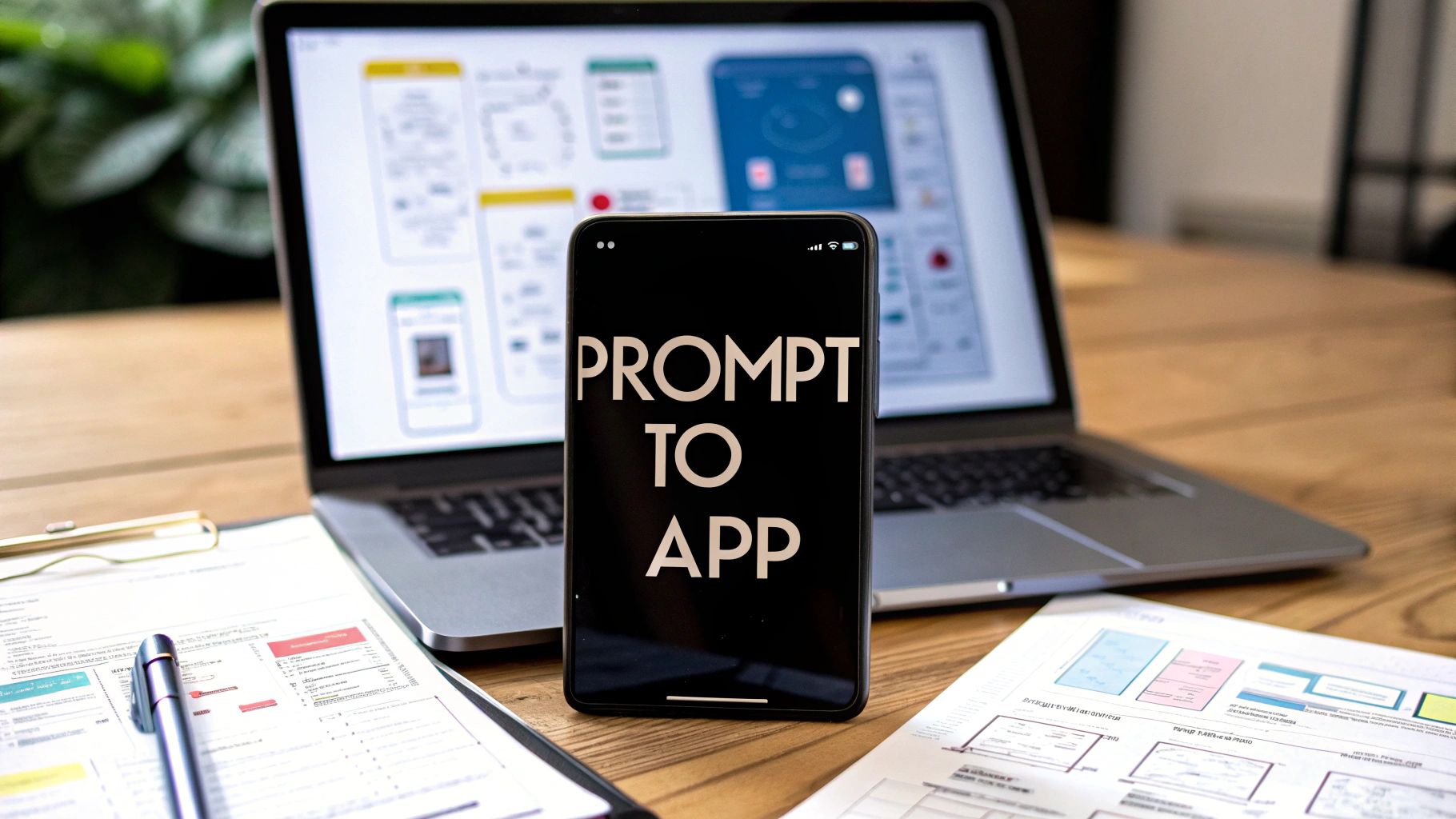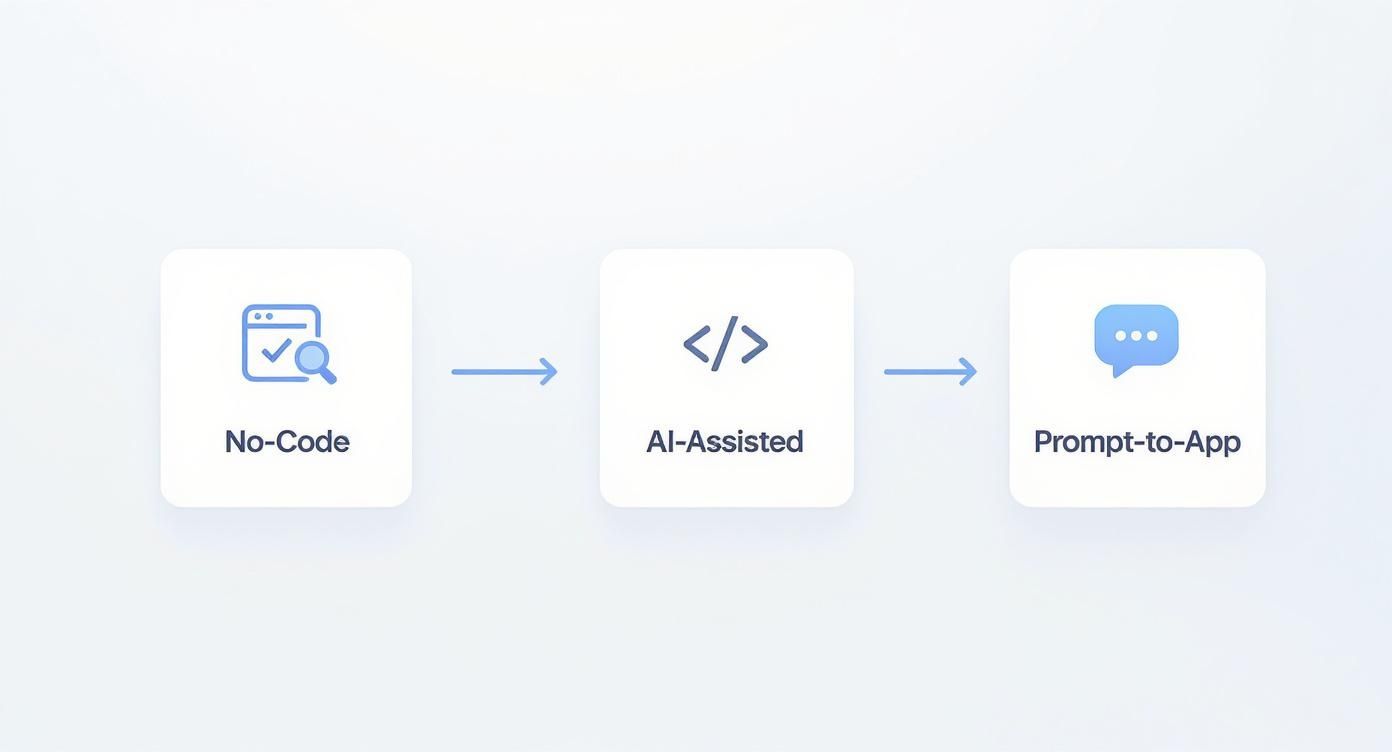Prompt to App: The Future of Building Software Is Here
Discover how the prompt to app workflow is transforming software development, allowing teams to build real applications from natural language.
By Damini
8th Nov 2025

AI has taught us that the real skill today isn’t coding—it’s prompting. We’ve all seen what happens when we ask ChatGPT to write an email or tell Midjourney to create a stunning image. This has quietly trained us in a new, vital skill: turning our ideas into clear instructions for an AI.
So, if AI can write text and create designs from simple prompts, the next logical question is obvious: why can't apps be built the same way?
This is exactly where prompt-to-app technology comes in. It represents the natural evolution of software creation, turning human language into usable, editable app code. App building is entering the same transformation curve we've seen with text and images, moving from a manual craft to an AI-driven conversation.
This shift is more than just a productivity hack; it’s a massive leap forward that gives founders, product managers, and developers a way to build faster and collaborate more seamlessly than ever before. For anyone hoping to speed up mobile development, understanding this new paradigm is essential. The ability to turn a simple sentence into a tangible, interactive product is truly changing how we build software.
What Does “Prompt to App” Mean?
At its core, “Prompt to App” is a workflow where a user describes an app in natural language, and an AI generates the UI, navigation, and working code automatically. It’s like describing your idea to a developer—except the AI actually builds it in seconds.
This process shifts app creation from a hands-on, manual chore into a simple conversation. Instead of dragging and dropping elements or writing endless boilerplate code, your main tool is language. The idea is to make building software as intuitive as talking.
How is it Different from Old Paradigms?
To understand why this is a big deal, let's contrast it with the methods we've been using up until now:
- No-Code Tools: These platforms let you build by clicking and dragging pre-built blocks. They're fantastic for simple websites or internal tools, but you are ultimately limited by the platform’s components and cannot export the underlying code.
- AI-Assisted Tools: These are developer sidekicks like GitHub Copilot that suggest lines of code or help with snippets. The AI assists, but the developer is still responsible for structuring the entire application from the ground up.
- Prompt-to-App: This approach is fundamentally different. It doesn't just help with snippets or lock you into a visual editor; it handles the entire app generation from a single, high-level instruction. It’s the difference between getting driving directions and having a self-driving car take you to your destination.
The Technology Behind Prompt-to-App
While it can feel like magic, the technology is a sophisticated system where different AI technologies work together. Here's a simplified breakdown of how an AI native app builder like RapidNative turns your words into a working app.
- Language Understanding: First, a Large Language Model (LLM) interprets your intent. When you say, “I want a to-do list app with reminders,” it understands the key concepts: "to-do list," "reminders," and the relationships between them.
- Component Mapping: Next, the AI translates those concepts into design structures. It knows a "to-do list" requires UI elements like lists, text inputs, and buttons, and it maps these concepts to a library of standard components, like those used in a framework like React Native.
- Code Generation: With the structure defined, the system writes clean, human-readable code. This involves creating the files for each screen, setting up the navigation, and writing the React Native and TypeScript code for every component.
- UI Rendering: Finally, the generated code is rendered into an interactive visual interface. This allows for a powerful feedback loop where you can see your app, click through it, and provide follow-up prompts for refinement.
You can learn more about how RapidNative translates prompts into functional designs in our documentation. The final output isn't a static image—it's a real, interactive interface built with production-ready code.
Why Prompt-to-App Is a Step Beyond No-Code
To clarify what makes the prompt-to-app model unique, it’s helpful to compare it directly to the tools that came before it. No-code platforms like Bubble and Webflow were revolutionary for non-technical creators, but they came with a ceiling on scalability and code ownership. AI-assisted tools like GitHub Copilot boosted developer productivity but didn't change the fundamental workflow.
Prompt-to-app technology offers a new paradigm that combines speed with control. You are not just getting suggestions or dragging boxes; you are handing off the entire initial build to an AI and receiving a complete, production-grade codebase in return.
Comparison of App Building Paradigms
This table breaks down the core differences between the three main approaches to building digital products today.
| Criteria | No-Code Tools | AI-Assisted Builders | Prompt-to-App Tools |
|---|---|---|---|
| User Input | Drag & drop | Guided coding | Natural language |
| Output | Web-based prototype | Partial code | Real, production-ready code |
| Speed | Moderate | Fast | Instant |
| Scalability | Limited | Medium | High |
| Code Export | ❌ | ✅ (partial) | ✅ (complete) |
As you can see, the prompt-to-app approach is the only one that combines the speed of AI generation with the freedom of complete code ownership. It handles the repetitive work of scaffolding the UI so your team can focus on the business logic and unique features that matter. It's the best of both worlds: instant creation upfront and total flexibility for long-term growth.
Step-by-Step: How “Prompt to App” Works in Practice
So, what does this workflow actually feel like? Let's walk through a practical scenario. Imagine you're a product manager with an idea for a mobile event planning app. Your journey now starts with a single sentence.
Step 1: Write Your Prompt
You begin by describing the app's core idea in plain English. There’s no need for technical jargon.
Example:
“Build a mobile app for event planning with home, RSVP, and calendar screens.”
This simple instruction gives the AI everything it needs: the app's purpose and the essential screens you envision.
Step 2: AI Parses and Designs
Instantly, the AI gets to work. It identifies the screens, their relationships, and the necessary components. It understands that an "RSVP screen" needs input forms, a "home screen" should display a list of events, and a "calendar screen" requires a grid layout.

Step 3: Visualize
Within seconds, an interactive prototype of your app appears in a preview canvas. It’s not just a static mockup—you can click through the screens and test the navigation because it's built from real code.
Step 4: Refine with Additional Prompts
Now you can iterate. Treat the AI as a creative partner, making changes with follow-up prompts.
Example:
“Add a dark mode toggle.”
The app updates instantly. This rapid feedback loop allows you to explore dozens of ideas in minutes, a process that used to take weeks. To learn more about structuring an app from the ground up, check out our guide on building a simple mobile application.
Step 5: Export the Code
Once you're happy with the result, the final step is exporting the code. A true prompt-to-app generator gives you the complete, human-readable source code as a full React Native project, ready for your development team to customize and deploy.
Real-World Use Cases
The real test of any new technology is how it solves problems for different roles. Prompt-to-app workflows offer distinct advantages for everyone on a product team.
- Founders: Generate high-fidelity MVPs in hours for investor demos and early market validation without burning through your initial capital.
- PMs: Achieve true stakeholder alignment by showing an interactive prototype instead of static mockups. Quickly build and test internal tools without pulling developers off the core product.
- Designers: Instantly visualize user flows with real app interactions, not just canned click-throughs. This allows for higher-quality feedback on usability long before development begins.
- Agencies: Rapidly scaffold new client projects based on an initial brief, showing tangible progress in the very first meeting and building immediate trust.
Example Prompt Ideas
To make the concept more tangible, here are a few example prompts that showcase the versatility of a prompt-to-app builder:
“Create a recipe app with a home feed and save button.”
“Build a meditation app with audio playback and session tracker.”
“Design a travel booking app with calendar and payments.”
The Benefits of Prompt-to-App Development

Adopting a prompt-to-app workflow delivers clear business and technical wins that address long-standing development bottlenecks.
- 10× Faster Prototyping: What used to take weeks of design and development can now be accomplished in a single afternoon, allowing you to test more ideas with fewer resources.
- Real, Extensible Code: Unlike no-code tools, this approach gives you a complete, production-grade React Native codebase. There’s no vendor lock-in, so your app can scale and evolve without limitations.
- Human Creativity + Machine Speed: The AI handles the repetitive boilerplate, freeing up your team to focus on what humans do best: strategy, creative problem-solving, and building unique features.
- Reduced Design-to-Dev Friction: The classic handoff friction between designers and developers disappears when a prompt directly generates the UI that everyone can see, test, and agree on.
- No Vendor Lock-in: You own your code from day one. You can take it, modify it, and host it anywhere you want, giving you full control over your technology stack.
The Challenges and Learning Curve
To be credible, it's important to acknowledge that prompt-to-app technology is still evolving. The tools are powerful, but they come with realistic caveats.
- Prompt clarity impacts results. A vague or poorly worded prompt will lead to a generic or flawed output. Learning to communicate your intent clearly is a key skill.
- Complex backend logic still requires dev input. While great for UI generation, these tools do not yet handle complex server-side logic, database schemas, or intricate API integrations.
- Early tools vary in code quality. As with any new technology, the quality and cleanliness of the generated code can differ between platforms.
However, even with these limitations, the iteration speed is unprecedented. The ability to instantly scaffold an application's frontend is a game-changer for any team building mobile products.
The Future of Software Creation
The prompt-to-app paradigm is just the beginning. We are moving toward a future where natural language becomes the primary interface for creating entire software systems.
Soon, prompt-to-app won’t just mean mobile—it’ll extend to backend workflows, APIs, and even app store deployments. Imagine describing a user signup flow and having the AI generate the server-side code, database tables, and API endpoints automatically.
For decades, building software required learning the machine's language. Now, the machine is finally learning ours. While deep skills in traditional programming languages will always be valuable, the barrier to creating something tangible is falling away.
This is the start of a new software creation era where language is the new interface. It empowers everyone—from founders to designers—to participate directly in the act of building, making development more conversational, collaborative, and incredibly fast.
Ready to turn your app ideas into real, working code in minutes? With RapidNative, you can describe your mobile app in plain English and get production-ready React Native code instantly. Stop wasting time on boilerplate and start building what matters.
Try RapidNative today and see the future of app development for yourself.
Ready to Build Your mobile App with AI?
Turn your idea into a production-ready React Native app in minutes. Just describe what you want to build, andRapidNative generates the code for you.
Start Building with PromptsNo credit card required • Export clean code • Built on React Native & Expo